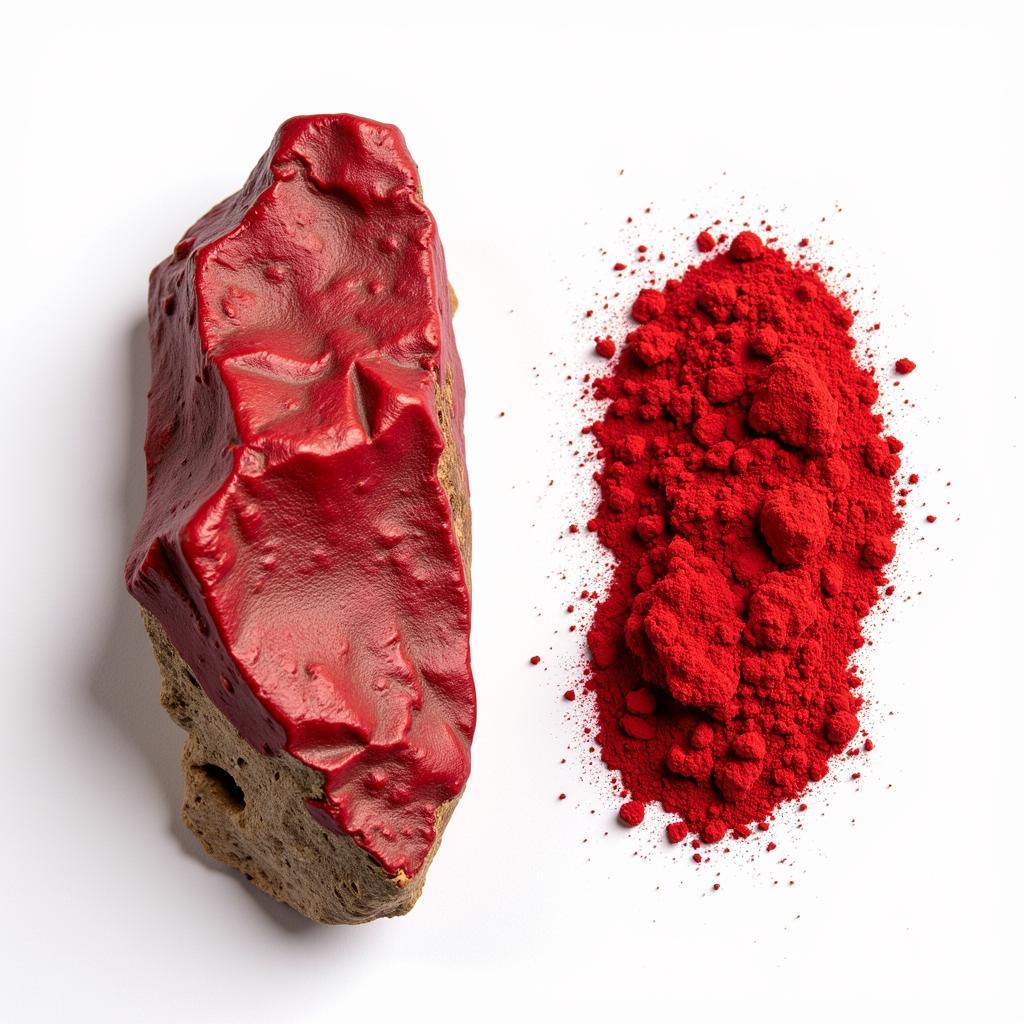Cinnabar, a color steeped in history and rich in symbolism, captivates with its fiery presence. But what color is cinnabar, exactly? This article delves into the nuances of this captivating hue, exploring its origins, properties, and various applications. Discover how this unique color can enrich your understanding of art, design, and even history.
Unmasking Cinnabar: From Mineral to Pigment
Cinnabar is more than just a color; it’s a naturally occurring mineral, also known as mercury sulfide (HgS). This vibrant mineral is the principal ore of mercury, and historically, it has been highly prized for its intense red pigment. The process of extracting the pigment from the cinnabar mineral involves grinding it into a fine powder. This powder, when mixed with a binding medium, transforms into the striking color we know as cinnabar.
 Cinnabar mineral and pigment
Cinnabar mineral and pigment
The intensity of cinnabar’s color varies, ranging from a bright, scarlet red to a deeper, more subdued reddish-brown. This variation is often due to the presence of impurities within the mineral and the specific grinding techniques used.
Cinnabar Throughout History: A Color of Power and Prestige
Cinnabar’s rich history adds another layer of fascination to its story. Ancient civilizations, recognizing its vibrant beauty, used cinnabar for everything from creating intricate artwork to symbolic rituals. The Romans, for instance, associated cinnabar with power and status, often using it to decorate the homes of the wealthy elite. Its use as a pigment in paints and inks can be traced back millennia, appearing in prehistoric cave paintings and ancient Chinese calligraphy.
Cinnabar vs. Vermilion: Untangling the Terminology
The terms “cinnabar” and “vermilion” are often used interchangeably, leading to confusion. While both refer to a vibrant red pigment, there’s a subtle difference. Cinnabar refers specifically to the naturally occurring mineral, while vermilion typically describes the pigment derived from either natural cinnabar or a synthetically produced mercury sulfide. To further understand the relationship between these terms, you might find our articles on vermillion helpful: what color is vermillion, what color is vermillion color.
What Color is Cinnabar Today? Modern Applications
Even in the modern world, cinnabar’s allure remains strong. Though its use is less common due to the toxicity of mercury, it continues to inspire artists and designers. Its unique hue can be found in specialty paints, inks, and even cosmetics, albeit in carefully controlled and regulated forms.
“Cinnabar is a truly special color,” says renowned color specialist, Dr. Anya Sharma. “Its depth and richness offer a captivating visual experience that is difficult to replicate with other pigments.”
Is Cinnabar Toxic? Handling Precautions
It is crucial to remember that cinnabar, due to its mercury content, is toxic. Direct contact with the mineral or its pigment should be avoided. When working with cinnabar-based products, always ensure adequate ventilation and follow safety guidelines. For a clearer understanding of the different shades of red, explore our article what is vermillion color.
Cinnabar: A Timeless Hue
Cinnabar, a color derived from the heart of the earth, carries with it a rich history and an undeniable allure. From ancient art to modern design, its vibrant presence continues to inspire. Understanding the origins and properties of this fascinating color allows us to appreciate its unique beauty and cultural significance.
FAQ
- What is the chemical composition of cinnabar? Cinnabar is mercury sulfide (HgS).
- Is cinnabar the same as vermilion? Cinnabar is the mineral; vermilion is often the pigment derived from it or synthetically created.
- Why is cinnabar less commonly used today? Due to its toxicity.
- Where can I see examples of cinnabar in art? Many museums house ancient artifacts and paintings featuring cinnabar.
- What precautions should I take when handling cinnabar? Avoid direct contact and ensure proper ventilation.
- What are some colors similar to cinnabar? Vermillion, cadmium red, and some shades of crimson.
- Can I still buy cinnabar paint? Specialty art suppliers may offer cinnabar-based paints, but always check for safety information.
Common Scenarios and Questions
- Scenario: You are restoring an antique painting and suspect it contains cinnabar. Question: How can I safely test for the presence of cinnabar?
- Scenario: You want to achieve a cinnabar-like color in a painting without using the toxic pigment. Question: What alternative pigments can I use to mimic the color of cinnabar?
Further Exploration
For more information on related colors and pigments, consider exploring these topics:
- The history of pigments in art
- The differences between natural and synthetic pigments
- The toxicity of heavy metals in art materials
Need help with colors?
Contact us for personalized color consultations and professional painting services. Call us at 0373298888, email us at [email protected], or visit our showroom at 86 Cầu Giấy, Hanoi. We have a 24/7 customer support team ready to assist you.
